How clean is our electricity? Well, there are a number of ways to answer that question. You can look at the grid itself, which we plug things into. How clean is the electricity on California’s grid, and how is it changing? A second way to answer the question is to look at what our power providers are purchasing. What does it mean when they say they are buying “clean” electricity, and is it fair to use that metric for our homes rather than the grid metric?
I’ll go over some of those questions in this blog post. These concepts may be familiar to many of you, but the cleanliness of our power is so important that it’s worth a refresher every now and then.
In 2021, California’s CAISO grid got 52% of its energy from low-emission sources (1):
- 33.6% from renewables (solar, wind, geothermal, biomass, small hydropower)
- 9.3% from nuclear energy (not considered renewable in CA)
- 9.2% from large hydropower (not considered renewable in CA)
The chart below shows how our energy supply has changed over the years. While the amount of electricity on the grid has remained relatively constant, in fact decreasing somewhat, the composition has changed. The top seven bands are the low-emission sources. (2)
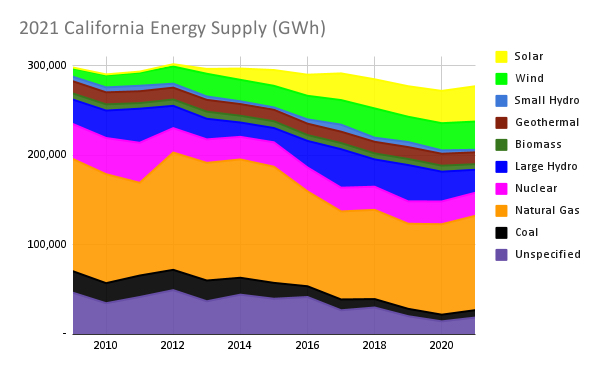
This chart includes imports, which in 2021 were 30% of our electricity supply. Data source: California Energy Commission’s Total Electricity Generation Report (2021) (3)
You can see the impact that hydropower fluctuation has, though the effect of California’s recent drought was partially offset by hydro imports from the Pacific Northwest. You can also see the effect of shutting down the San Onofre nuclear reactor in 2012.
What you do not see, though, is a steady increase in our supply of clean energy. There’s been a plateau since 2017, revealing a robust reliance on natural gas. In order to hit California’s goal of 100% clean electricity by 2045, we need to get past that and deploy massive amounts of solar, wind, and battery storage.
How do we do that? Well, the regulatory agencies are now turning the screws on power providers. They are requiring the big utilities and smaller community choice agencies to purchase more clean power, to ensure they have capacity that is available when customers need it (e.g., in evenings), and to reduce the use of accounting tricks that make a power portfolio look cleaner than it is.
The experience of East Bay Community Energy (EBCE) reflects this regulatory push. This East Bay power provider has since its inception aimed to provide its customers with low-emission, low-cost power that does not rely on nuclear energy. They purchase enough capacity to meet peak demand in each month plus some reserve. But that is getting harder as regulators tighten up. The reserve amount has been increased from 15% to 16% and soon 17%. In a few years the monthly match-up will be hourly -- EBCE will have to buy enough capacity to meet its peak use every hour of every month. To make matters even tougher, regulators are more severely discounting solar and wind resources -- they are worth much less for capacity requirements in 2023 than in 2020 -- because the proliferation of these resources has led critical supply hours to shift to when these resources are not available. The right-hand chart below shows that a solar plant is now worth exactly nothing in terms of meeting capacity requirements in January. A 100 MW solar plant with no batteries is worth at most 15 MW when it comes to compliance, and typically much less. (4)

The Effective Load Carrying Capability (ELCC) values that regulators use to determine how much of a renewable resource will contribute to addressing peak loads are getting lower as renewables have proliferated and caused peak times to shift away from when renewables produce. Source: East Bay Community Energy Board Retreat (2023)
On top of this, in three separate rulings the California Public Utilities Commission (CPUC) has gone beyond the usual planning process to require power providers to step up and purchase additional “net qualifying capacity” that is available at critical hours (e.g., summer evenings). EBCE is on the hook for about 650 MW, which in practice is much more given the discounting that the CPUC employs.

The CPUC has issued several significant requirements for additional “Net Qualifying Capacity” that is available at peak times, in order to reduce the risk of outages in summer and fall. These requests are portioned out to the various power providers based on their share of overall demand. For EBCE that is about 3%. Source: East Bay Community Energy Board Retreat (2023)
All of this means that power providers are purchasing more clean energy, and more capacity that is available in evenings, nights, and early mornings. EBCE lists some of its recent energy contracts below. Look at the emphasis on storage, which allows solar energy to be shifted away from midday, and some low-emission baseload geothermal.
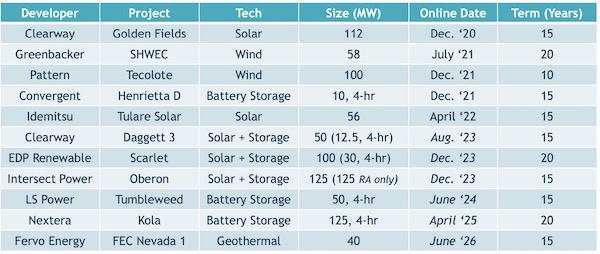
East Bay Community Energy has been purchasing more clean power that is available during peak times, in order to comply with increasingly stringent requirements. Source: East Bay Community Energy Board Retreat (2023)
East Bay Community Energy has set a goal to provide their 1.7 million customers with 100% clean energy by 2030 and to continue to do this at a cost cheaper than PG&E. This leads me to a question I posed at the start of this blog, namely instead of using the grid mix to evaluate how clean your electricity is, can you instead look at what your own power provider is purchasing and use that? I would say yes but with some caveats. If you want to take that approach, look at the “emissions intensity” of those purchases, which are helpfully recorded on a Power Content Label from your power provider. It is like a nutrition label for an energy supply.
You can find one for East Bay Community Energy here, where you will see that EBCE’s 2021 emissions intensity (564 lbs CO2e/MWh) was substantially higher than the state’s average (456) due to a large amount of Unspecified Power. This happened because sales exceeded renewable purchases -- the market purchases EBCE made to close the gap are recorded as Unspecified -- and because some of the renewable energy they purchased was imported and mixed with non-renewable energy to provide a steady supply. California assigns high emissions to that type of blended (aka “PCC2”) power.
The Power Content Label is one of many places where California is tightening up on the definition of “clean” electricity. Power providers that have in the past claimed to provide clean electricity may find those claims harder to make as the state insists that power providers put verifiable clean energy on the California grid, report on how they are matching supply with demand on an hourly (not just an annual) basis, provide ample power at times of peak usage, and minimize the use of accounting tricks.
This is all good in terms of emissions, but it can increase costs for power providers who have more constraints on their purchases. Several years ago, Peninsula Clean Energy estimated that removing blended (PCC2) renewable imports from their portfolio would cost $5M, or 2.5% of their budget. Since then, increased demand for clean products has only pushed prices up. Monica Padilla, Chief Operating Officer & Director of Power Resources for Silicon Valley Clean Energy (SVCE), spoke in a SVCE board meeting last week: “Those carbon-free resources along with RPS resources are in high demand (due to state policies) and are therefore very very expensive. We’ve seen RPS resources for this calendar year almost triple in price from where it was last year. So our ability to offer these clean products … is becoming more of a challenge in terms of finding resources at an affordable price.” She suggested that at some point the SVCE board may need to vote on a tradeoff between clean and cost.
The City of Palo Alto Utilities opted in 2020 to provide a less clean portfolio in order to keep costs down. Take a look at the Emissions Intensity that each of the local power providers reported on their 2021 Power Content Labels.
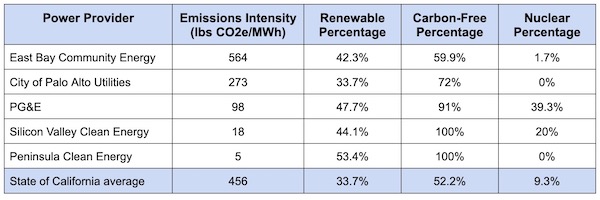
Power providers make different choices when constructing their portfolio, based on community preference, rate guidance, and other factors. Some of the resulting data for the base products is shown above. (Data Source: 2021 Power Content Labels: EBCE, CPAU, PGE, SVCE, PCE)
Palo Alto’s municipal utility has long purchased clean power, but it has an equally important goal to keep its rates low. As transmission costs have increased, as drought has impacted Palo Alto’s reliance on hydropower, and as increased demand has strained the distribution grid, Palo Alto has struggled to keep costs down. Early in the pandemic, the city opted to sell some of the renewable credits it earns from its portfolio in part to keep rates low. It now reports only the minimum amount of renewable energy required by the state. The remaining power is downgraded to “Unspecified,” which is reported with higher emissions. (5)
Is this the right tradeoff? Palo Alto did this in part to reduce customer bills, but now it is allocating the proceeds towards its electrification efforts. Senior Resource Planner Jim Stack says: "We believe that local decarbonization efforts (incentivizing electrification, etc.) will have a greater environmental impact than simply adding more solar power to the grid in the middle of the day." East Bay Community Energy is prioritizing renewables over carbon-free energy in its rejection of nuclear power. Silicon Valley and PG&E focus on overall emissions reductions and are technology agnostic. Peninsula Clean Energy is pursuing clean energy on a 24x7 basis. Each power provider chooses how to construct its portfolio while complying with state policies. (6)
That brings me to the second caveat about how clean your energy is. How careful is your power provider at aligning its purchases with customer demand on an hourly basis? (7) If your provider is not careful, and few are (though regulators are pushing on this), then your provider’s energy purchases are being supplemented by dirtier energy during evenings and other peak times, effectively worsening the emissions intensity of the energy they are providing. This energy is available because of those “capacity” purchases, but it is not reflected on the Power Content Label.
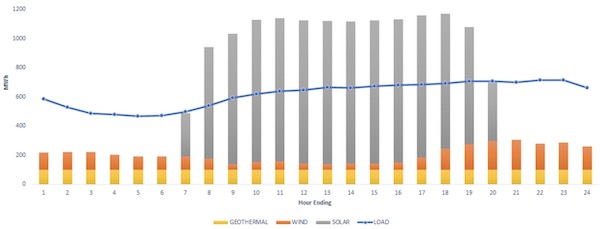
In this hypothetical example, if a “clean energy” power provider does not align its purchases (supply) with demand (aka load, shown in blue), then its customers are effectively using dirtier energy during the hours that its purchases fall short. Image source: East Bay Community Energy Board Retreat (2023)
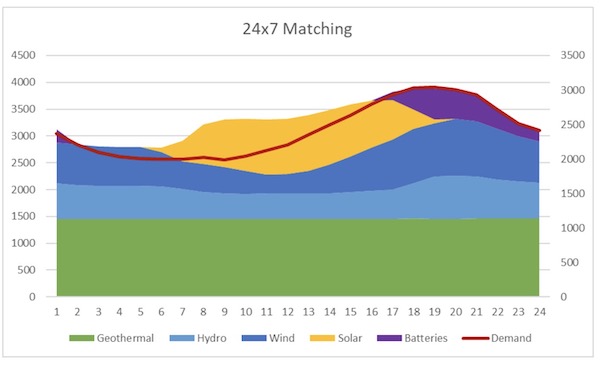
In this hypothetical example, where clean power is provided to meet demand for each hour of the day, a customer can be assured that whenever they are using electricity from this power provider, it is clean. It is also significantly more expensive. Image source: Silicon Valley Clean Energy Study Session (2023)
So part of the answer to the question “How clean is our electricity” depends on you -- when are you using energy? The more midday energy you use in California, the cleaner your energy will be. If you primarily use grid energy when the sun is down, then you are using the dirtiest energy on the grid. On the other hand, if you are able to shift some of your demand (e.g., charging your EV) to midday, then you are using some of the cleanest energy that your provider is purchasing and keeping costs down at the same time. Appliances are rolling out to help automate this process of using electricity at the cleanest and cheapest times, which is great.
So, how clean is our electricity? With a broad brush stroke, I would say that it is “half” clean, based on the grid mix. But it can be considered cleaner if your power provider is diligent about keeping a low emissions intensity and aligning supply with demand, and/or if you are able to use more midday energy.
I am interested to hear your thoughts on our electricity supply and how it is evolving, so please share in the comments.
Notes and References
0. Thank you very much to the staff at East Bay Community Energy for reviewing this post and answering my many questions.
1. This is in the weeds, but … You may have read somewhere else that “in 2021, 59% of the state’s energy came from renewable and zero-carbon resources”, which differs from the 52% that I show in this post. The CEC has a new dashboard that reflects this same 59% metric.

The state’s dashboard compares renewable generation (at the point of production) with retail sales (as delivered to the customer). It therefore ignores energy that is lost via transmission and distribution. This effectively makes the percentage higher. The data I illustrate at the top of the blog post, leading to the 52% value, compares all renewable generation (at the point of production) to all generation (also at the point of production), so it includes energy that is lost during delivery. (The numerator and denominator for the 52% computation also include energy for non-retail uses, such as water pumping and municipal lighting.)
2. This graph does not show the emissions intensity of the grid, which would more accurately depict the cleaning of our grid. I expect that graph would decrease somewhat faster given the drop in coal and the cleaning up of our gas generation.
3a. Unspecified power refers to electricity that is not traceable to a specific generating facility, such as electricity traded through open market transactions. Unspecified sources of power are typically a mix of resource types, and may include renewables. This category can also include spot market purchases, wholesale energy purchases, energy that has been unbundled from its renewable credit, and purchases from pools of electricity where the original source of fuel can no longer be determined.
3b. You may find it curious that our electricity supply has actually decreased over the past ten years. One thing to keep in mind is that rooftop solar is not included in this chart, and that is now around 25,000 GWh. Even so, our supply (and demand) would be flat. The California Energy Commission estimates that in the next few years, rooftop solar’s growth will be outpaced by increased demand from electrification, and demand will begin to increase.
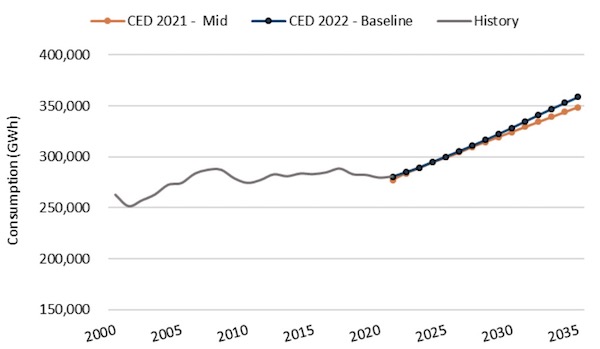
Forecast demand growth, including behind-the-meter demand. Source: California Energy Commission’s Integrated Energy Policy Report (2022)
4. Power providers like EBCE are required to procure both capacity and energy. Capacity purchases are focused on reliability, with the goal of preventing outages by being available during critical hours. There are few clean requirements when it comes to capacity purchases. Silicon Valley Clean Energy, for example, meets its capacity requirements primarily through natural gas, and almost all power providers have some gas in their “capacity” portfolio for this purpose. These capacity purchases are not reported on the Power Content Label but they are reported in the Integrated Resource Plan that every power provider must file. Energy purchases, on the other hand, are not subject to such stringent time of use requirements (though that is changing, starting with new reporting requirements), but they do need to be relatively clean. Many contracts provide both energy and capacity, but power providers can also purchase either one separately. Municipal utilities like Palo Alto are not subject to some of this.
5. In addition to selling renewable credits, Palo Alto is also purchasing some heavily discounted credits in order for its carbon-neutral energy accounting to match supply with demand on an hourly basis. These discounted credits, based on imported renewables from states that may not value renewable energy, are discouraged by the CPUC because they do little to help the environment. Palo Alto is revisiting its REC trading this year as it evaluates its portfolio. You can read more in Appendix C of this document and Appendix B of this document.
6. Palo Alto Utilities is a municipal utility, and as such is subject to fewer requirements than the other power providers discussed in this document. As one example, they are not being asked to buy the large amounts of net qualifying capacity that others must.
7. An alternative approach to matching supply with demand on an hourly basis, which can be complicated and wasteful, is to focus on deploying clean energy when the grid is dirtiest. By doing that, a power provider displaces the most emissions and maximizes its contribution to a cleaner grid. This approach proposed by Google may be simpler and more effective, and is something Silicon Valley Clean Energy will be evaluating this year along with an hourly matchup approach.
8. Many of the images in this blog post come from a presentation that the East Bay Community Energy Power Resources team did for its board in March. You can find a video of that presentation here. In addition, Silicon Valley Community Energy last week held a study session titled “Emissions Accounting: What is Clean?”, with video here and slides here.
Current Climate Data (April/May 2023)
Global impacts, US impacts, CO2 metric, Climate dashboard
I took this photo near Tahoe City recently. It’s a nice visual of a thinned forest next to an untreated one.
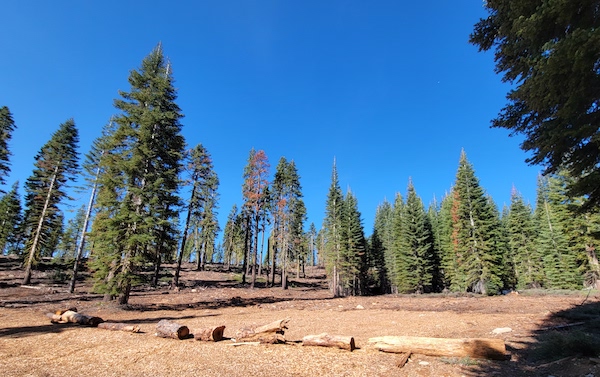
There seem to be many healthy firs in the untreated stand, but if you look closely you can see that many are dying. (They die from the top.) You can find a larger version of the photo here. You can read more about why trees are dying in Tahoe here.
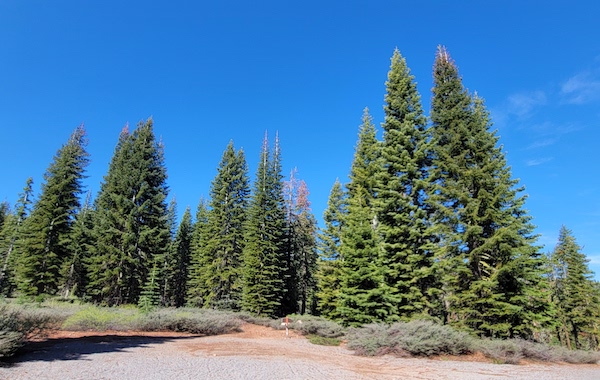
Comment Guidelines
I hope that your contributions will be an important part of this blog. To keep the discussion productive, please adhere to these guidelines or your comment may be edited or removed.
- Avoid disrespectful, disparaging, snide, angry, or ad hominem comments.
- Stay fact-based and refer to reputable sources.
- Stay on topic.
- In general, maintain this as a welcoming space for all readers.



